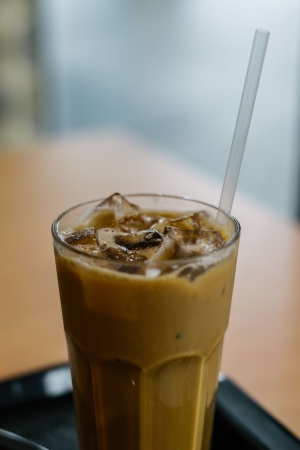Hello! Singapore バックナンバー・第2回
国際交流員(CIR)が、加賀市での生活のことやシンガポールのことを紹介します♪

こんにちは!2021年10月から加賀市に配属された、シンガポール出身の国際交流員のアガサです。毎月、Hello! Singaporeで、私が感じた加賀市とシンガポールの違いをいろいろ紹介したいと思います。みんなさんぜひ読んでみてくださいね!
Hello! I'm Agatha from Singapore, and I have been Kaga City's Coordinator for International Relations since October 2021. Every month, in Hello! Singapore, I explore some of the many differences between Kaga and Singapore. I hope you will give the column a read!
第2回 シンガポールの紅茶とは…?(5月25日更新)
ゴールデンウイークに、他県に住んでいる友達とジェラートを食べに行きました。
During Golden Week, a friend from another prefecture came to visit, and we went to a gelato shop together.
「おすすめは?」と彼女が聞きました。
“What do you recommend?” she asked.
「せっかくここまで来たから、加賀棒茶しかないよ。」と私は答えました。
“Since you’ve come all the way here, you have to try the Kaga bocha,” I said.
加賀棒茶は、スーパーやお土産屋、いろいろな所で販売されていて、ケーキ、プリン、ジェラートなどのデザートにもよく使われます。石川県民のみなさんが知っている定番の飲み物ですね。
Everyone in Ishikawa knows about Kaga bocha. It’s an everyday drink in the region, an especially roasty type of hojicha sold everywhere, from supermarkets to souvenir shops. It’s also commonly used to flavor cakes, pudding, and, yes, gelato.

加賀棒茶/Kaga Bocha
味が軽く、でも風味豊かな加賀棒茶が好きですけれど、私はやっぱりシンガポールの安くて、伝統的な紅茶が恋しいです。ホーカーセンターという屋外のフードコートや公共アパートの一階にあるコーヒーショップで売られて、どこでも買えるものです。マレー語で紅茶という意味の「テ」と呼ばれますが、カスタマイズする方法によって、呼び方が変わります。
Kaga bocha is delicate yet flavorful, and while I love it, I can’t help but miss the cheap traditional tea you can get anywhere back in Singapore, like in the hawker centers—outdoor food courts—and the coffee shops under public flats. It is known simply as teh, which is the Malay word for tea, but there are many variations based on what you’d like added, or not added, to it.

基本は「テ・オー」(ストレート)、「テ」(練乳入り)、「テ・シー」(無糖練乳入り)の三つがあります。次はカスタマイズの言葉を追加します。よく聞かれるのは「ペン」(冷たい)、「コソン」(砂糖なし)と「シウ・ダイ」(砂糖少なめ)です。例えば、私がいつも注文するのは冷たくて、練乳の入った、砂糖は少なめの「テ・ペン・シウ・ダイ」です。
There are three basic options: teh o (straight tea), teh (tea with condensed milk), and teh c (tea with evaporated milk). You can then go on to customize it further by adding more words to the name while ordering. Popular options include peng (iced), kosong (no sugar), and siew dai (less sugar). For example, my usual order is teh peng siew dai: iced tea with condensed milk and less sugar.

テ・タリック/Teh Tarik
「テ・タリック」という高く上げたコップから紅茶と練乳を注いで混ぜるテを作る店もあります。
Some stalls even offer teh tarik—a frothy teh that is mixed by pulling. In other words, by pouring the teh from one cup, raised high, into another.

コピ・ペン/Kopi peng (Photo by bady abbas on Unsplash)
「テ」の代わりに、「コピ」と言えば、シンガポールの伝統的なコーヒーも注文できますよ!「コピ」は「テ」と同じく、マレー語でコーヒーという意味の言葉です。スターバックスなどのカフェと違って、アラビカ種の豆ではなく、砂糖とバターやマーガリンと焙煎されたロバスタ種の豆が使われるから、特に濃厚です。
You can actually also do this with coffee, instead of tea. Singapore’s traditional coffee—known as kopi, which is the Malay word for coffee—uses Robusta beans, usually roasted with sugar and butter or margarine. This produces a darker, stronger brew than the usual Arabica beans used in cafés like Starbucks. If you’re more of a coffee drinker, simply replace the word teh with kopi and you’re good to go!
テ・オー/Teh O
コピとテの注文のし方は、初めてシンガポールに来る外国人にとって、複雑すぎて難しいかもしれません。シンガポールで生まれ育った私も、初めてテを注文したとき、混乱してしまいました。でも、慣れると難しくないし、ミスをしても大丈夫です。もしシンガポールに行く機会があれば、ぜひいろいろなカスタマイズを試してみてください!
Foreigners who are new to Singapore might, understandably, find this overwhelming. I was born and raised in Singapore, but when I first started ordering teh in my teens, I was also confused. But it really is less intimidating than it seems once you get used to it, and no one will laugh if you get it wrong. If you ever visit Singapore, just have fun trying out different combinations until you find something you like!
この記事に関するお問い合わせ先
こちらのページも見ています









更新日:2024年04月26日